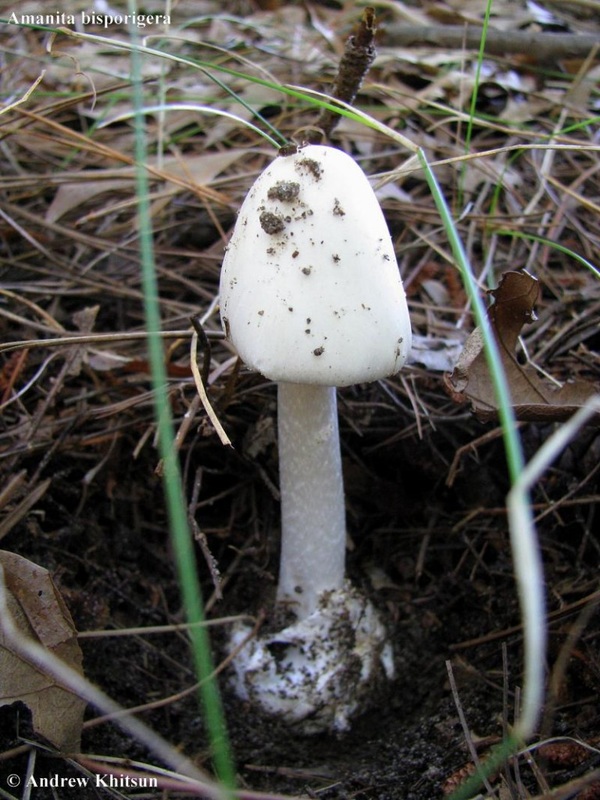|
This is the most widely distributed and commonly encountered “destroying angel” of eastern North America. Like other members of the species group it features stark white colors and a prominent sack around the base of the stem, along with a bald cap that almost always lacks patches or warts. As it is currently defined (read: in the absence of published DNA studies), Amanita bisporigera can be separated from the other destroying angels on the basis of its two-pronged basidia, its round spores, and the yellow reaction of its cap when a drop of KOH is applied.
The western North American destroying angel, Amanita ocreata, can be separated on the basis of its range and its (usually) stockier proportions, along with its ellipsoid spores; it also turns yellow with KOH. Other eastern North American destroying angels feature ellipsoid spores and do not turn yellow with KOH; they belong to the Amanita elliptosperma group–a taxonomic teapot tempest of synonyms and minor putative differences (for example, the sturdy ring of Amanita magnivelaris). Fortunately for would-be mushroom identifiers, these species are much less common, in comparison to Amanita bisporigera, and are infrequently collected. The names Amanita virosa and Amanita verna are often applied to various North American destroying angels in field guides, but those names represent European species that do not occur naturally in North America; the former species turns yellow with KOH while the latter does not. Volvopluteus gloiocephalus (also known as Volvariella speciosa) can appear very similar to the destroying angels. However, it lacks a ring, has a pink spore print and pink mature gills, and is usually found growing in gardens, lawns, woodchips, and other urban places. Description: Ecology: Mycorrhizal with oaks, and possibly with other hardwoods; summer and fall; widely distributed and common in eastern North America from Texas to the north woods and the maritime provinces. Cap: 2.5-10 cm; almost oval, becoming convex, then broadly convex to somewhat bell-shaped or nearly flat in age; bald (very rarely with a volval patch); dry or a little sticky; stark white to ivory, sometimes discoloring towards the center in age–or rarely a little yellowish or pinkish with maturity; the margin not lined. Gills: Free, or nearly free, from the stem; close or crowded; with frequent short-gills; white. Stem: 5.5-14 cm long; 0.5-2 cm thick; usually tapering somewhat to apex and flaring to an enlarged base; somewhat shaggy or nearly bald; white; with a persistent, thin, high, skirtlike ring; with a white, sacklike volva encasing the base, which may be underground or broken up. Flesh: White throughout. Odor: Not distinctive in young specimens, but often becoming foul and unpleasant (sickly sweet, or reminiscent of rotting meat) with old age. Spore Print: White. by Michael Kuo Kuo, M. (2013, March). Amanita bisporigera. Retrieved from the MushroomExpert.Com Web site: |
|
If You Suspect a Poisoning
If you suspect you have consumed a poisonous mushroom, contact a physician, the closest hospital ER, poison control center, or dial 911, depending on the severity of the reaction. US Poison Control: 1-800-222-1222 The North American Mycological Association (NAMA) has information that may also be of help. Click here. We do not ID mushrooms through this website.
If you are in need of an ID consider uploading quality photos with multiple views of your specimen and descriptions of your find to Mushroom Observer or iNaturalist including our projects or post in Wild Food Wisconsin or Mushroom Identification Group. If you contact us and provide a way to get back to you, we may be able to provide suggestions for more identification resources you can use. You are always responsible for your own decisions taken on the basis of identification resources. |
Wisconsin Mycological Society (WMS) is dedicated to the study and enjoyment of mushrooms and other fungi throughout the state of Wisconsin. Education, safety, sustainability, community, and connecting with nature are our goals.
|


 RSS Feed
RSS Feed
